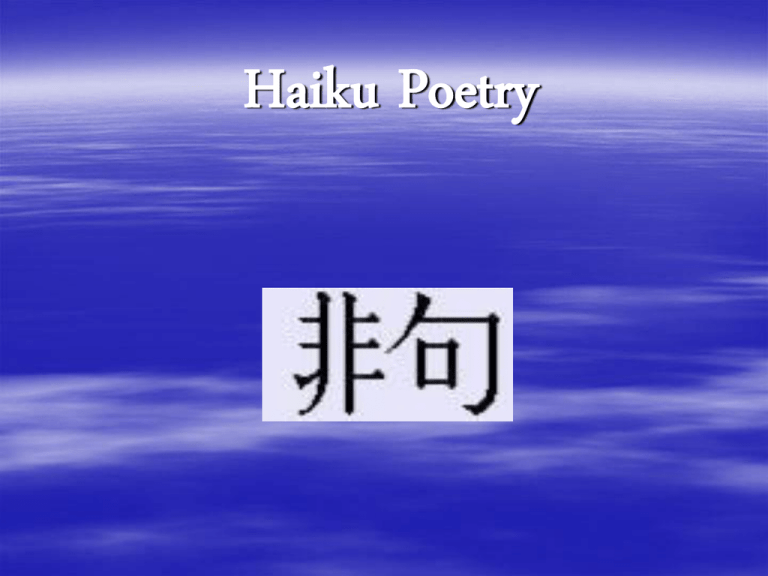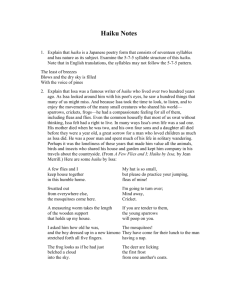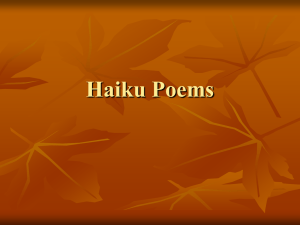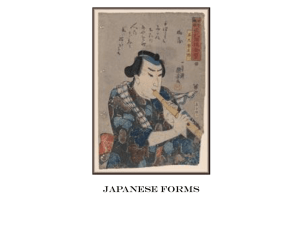Haiku Poetry
advertisement

Haiku Poetry A Famous Poet Issa Kobayashi was born in Japan in 1763, more than two hundred years ago. by Shumpo Muramatsu Issa had a poet’s eyes. He noticed things many people would not. He took the time to look, to listen, and to enjoy the movements of the many small creatures who shared his world, like sparrows, crickets, and frogs. Issa had a compassionate feeling for all creatures, including fleas and flies. He felt even common houseflies have a right to live, and would not swat them. In many ways, Issa’s life was a sad one. His mother died before he was two, and his own four sons and a daughter all died before they were a year old, a great sorrow to a man who loved children as much as Issa did. Issa was a poor man and spent much of his life in solitary wandering. Perhaps it was the loneliness of these years that made him value all the animals, birds, and insects who shared his house and garden and kept him company in his travels about the countryside. Issa’s House At the age of 25, Issa began to write haiku poems. Many of his poems are about the humble creatures he loved. Here is one of Issa’s haiku poems. A few flies and I Keep house together In this humble home. This is the way one of Issa’s poems looked when he wrote them. Some of Issa’s poems contain a beautiful image. Some are funny. Some make you think. Swatted out From everywhere else, The mosquitoes come here. A measuring worm takes the length of the wooden support that holds up my house. The frog looks as if he had just belched a cloud into the sky. My hut is so small, but please do practice your jumping, fleas of mine! If you are tender to them, the young sparrows will poop on you. The mosquitoes! They have come for their lunch to the man having a nap. I asked him how old he was, and the boy dressed up in a new kimono stretched forth all five fingers. Haiku was created centuries ago. It was treasured for its pure form and exquisite content. Western culture has grown to love and respect this special type of poetry. Writing your own haiku is easy. Follow these seven easy steps. Step 1: Form Your Haiku should have three lines with or without a seventeen-syllable count. It should be one breath long. old pondfrog jumps in sound of water - Matsuo Basho (Japanese poet, 1644-1694) Step 2:Image Your Haiku should have a descriptive image. For example, not a “flower,” but instead a “purple iris in the sun”. evening breezewater splashes against a blue heron’s legs - Yosa Buson (Japanese poet, 1716-1783) Step 3: Kigo (a season word) Your Haiku should refer to nature and hint at the season or weather. off they leap grasshopper mother and child and turn to grass - Katsushi Hosokawa (Japenese poet, age 10) Step 4: Here and Now Basho said, “Haiku is simply what is happening in this place, at this moment.” You should write from real experience, not imagination; record the present moment. for a second a butterfly settles on my cheek I must not breathe - Myriam Suchet (French poet, age 15) Step 5: Feeling Your Haiku should not explain or tell, but instead show the feeling through your image. along with spring leaves my child’s teeth are coming in - Nakamura Kusatao (Japanese poet, 1901-1983) Step 6: Surprise! Your Haiku should have an “ah!” moment that wakes us up. in a mouse’s nest someone’s love letter was found - Unknown Japanese Poet Step 7: Compassion Your Haiku should express openheartedness toward nature. Don’t hit the flyHe prays with his hands And his feet - Kobayashi Issa (Japanese poet, 1763-1827) Let’s Review! Haiku Form Three lines Syllable pattern of 5,7,5 Usually doesn’t rhyme Usually about nature Often includes a reference to a season Often a single sentence, but may be sentence fragments Now try writing your own! Bibliography Haiku: the Poetic Moment http://norazpoets.org/index.php?module=pagemaster&PAGE_user _op=viewPAGE_id=93 Issa’s Haiku Home Page www.threeweb.ad.jp/logos/ainet/issa.html Haiku www.1lo.sanok.pl/~iz/haiku/Issa.htm National Clearinghouse for U.S. –Japan Studies. http://www.indiana.edu/~japan/LP/LS3.html Steve Shaluta Photography http://www.steveshaluta.com/insects/inchworm-01.htm Kotobuki Wedding Attire http://www.kimonowedding.com/gallery_children.htm











